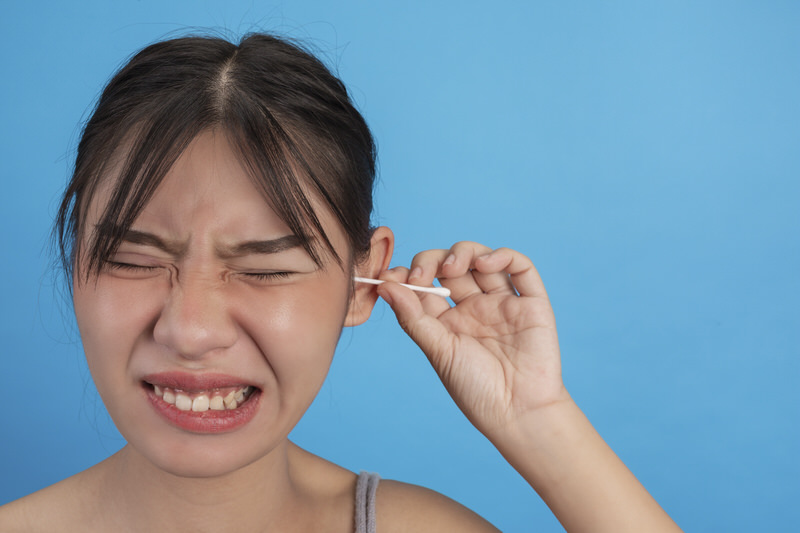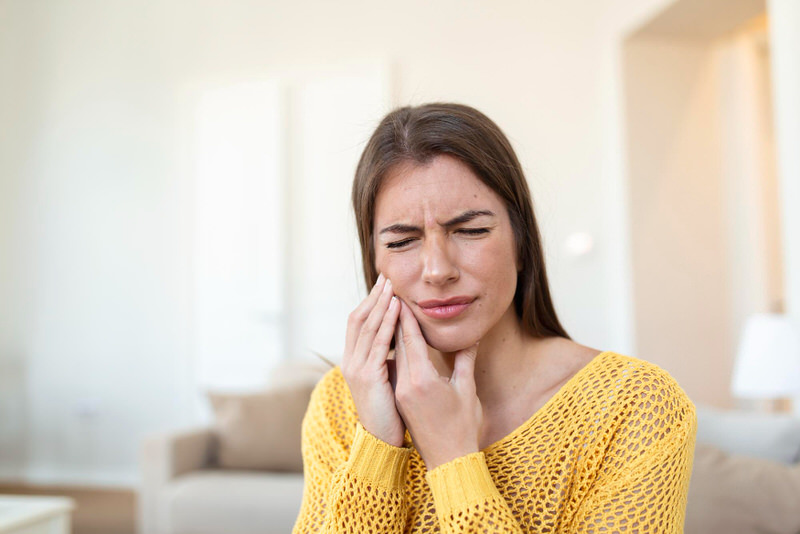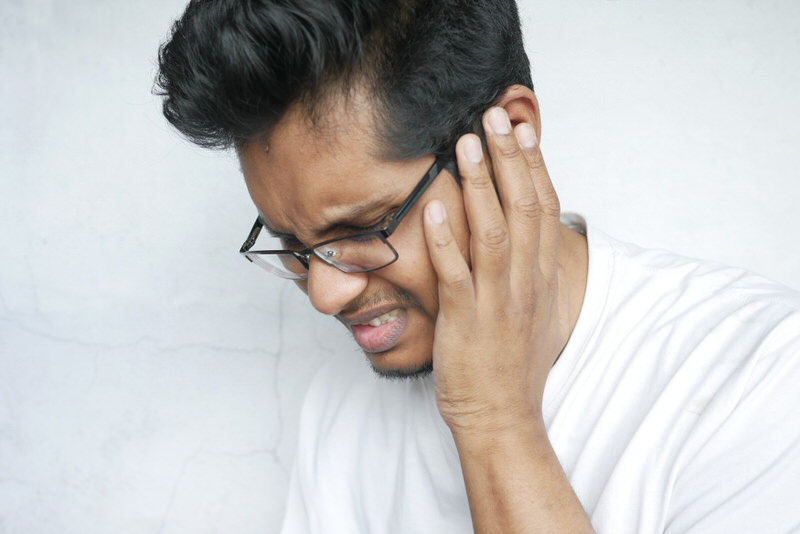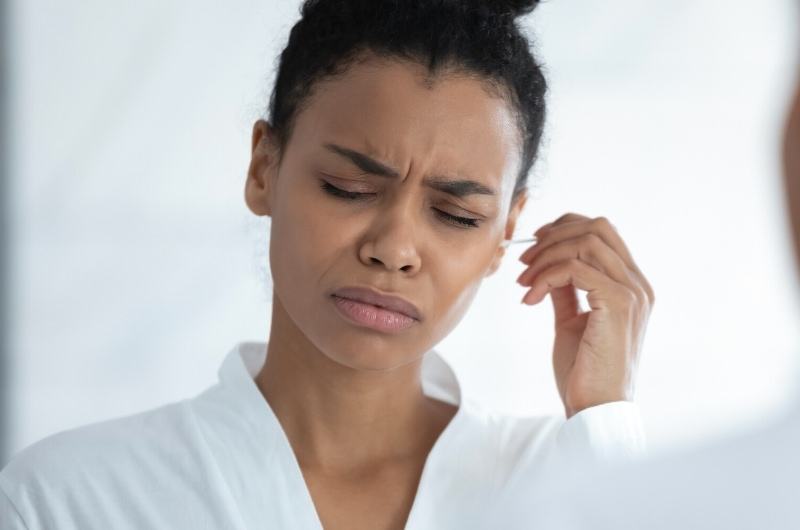A sudden ringing or rubber band sound in your ear may happen for many reasons. Children and adults may experience this symptom due to an ear condition or an earwax build-up. You may treat them with at-home remedies like yawning, chewing a piece of gum, drinking plenty of fluids, using nasal spray, applying a warm compress, or blowing through your nose. However, an ENT specialist’s intervention is needed when an underlying ear disorder is causing the rubber band sound.
When I was a kid, my grandmother brought me to an ear doctor because I suffered from a high-pitch ringing sound in my right ear. It happened after I cleaned my ears with a Qtip the wrong way.
The doctor found a build-up of earwax that got pushed back deep inside my ear. He then prescribed me to use an ear drop.
A week later, he cleaned my ears with a long, thin, noisy tool that sucked out the clogged wax. I left the clinic feeling like I just had a new ear.
What causes the rubber band sound in your ear?
1. A build-up of ear wax
Earwax or cerumen is naturally produced by our body to lubricate our ears and protect them from unwanted foreign materials like dust and microorganisms.

An excess amount of earwax would naturally find its way out from our ears.
However, if you habitually use earplugs or clean your ears with cotton swabs, you are prone to blocking your ear canal. These practices may push excess wax back inside your ear, forming a build-up.
When ear wax builds up, it will give the following symptoms:
- Difficulty or abrupt partial loss of hearing
- Pain and itchiness in the affected ear
- Ringing or weird sound in the ear
- A feeling of fullness in the ear
- Earwax discharge or odor from the ear
If you experience a rubber sound in your ears along with the symptoms mentioned above, you must see your doctor immediately.
An ear, nose, and tongue (ENT) specialist will use an otoscope to examine your ears to see if there is an impacted wax build-up.
What should you do?
You must consult your doctor to examine your ear for an impacted wax build-up. He/she will most likely prescribe an ear drop that will help soften the wax. Then, when the earwax is soft enough, it will be ready for removal.
Your doctor will use a special instrument (an ear micro-suction tool) that performs like a vacuum sucking out the earwax from my ear. Your doctor may manually remove the blockage using a curette if an ear micro-suction isn’t necessary.
You may also try at-home remedies but keep the build-up wax inside your ear intact. It may lead to damage and infection of your eardrums.
Below are some things you can do at home:
- Use over-the-counter ear drops. You may follow the instructions on the box for the dosage and use a clean cloth to remove the wax that will come out from your ear.
- Alternatives like mineral oil, baby oil, glycerin, hydrogen peroxide, or olive oil may also work. Again, do not use a cotton swab to clean the deep part of your ear. Only remove the earwax that is seen on the outer part of your ear with a clean cloth.
- Flush it out using a saline solution. Your doctor may perform this procedure, or you can use a home bulb syringe and water kit.
2. Temporomandibular joint (TMJ) and muscle disorders
If the rubber band sound in your ear occurs with pain when you’re eating or talking, it may be due to TMJ and muscle disorder.

The temporomandibular joint is located between your lower jaw and your skull, just near your ear canal. It’s responsible for the movement of your jaw when talking or eating.
Below are some of the common symptoms of a person with a TMJ and muscle disorder:
- Pain in the face or neck
- Difficulty in moving the jaw at a full range
- Headaches
- Earaches associated with buzzing and ringing sounds
- Unusual sound like clicking or popping when moving the jaw
Your primary healthcare physician may recommend you to a dentist or an ENT specialist to diagnose your condition. There are no standard tests for this type of disorder. However, doctors will assess your symptoms and check your jaw for any signs of abnormalities.
You might also need to undergo imaging tests to rule out the condition.
What should you do?
You may treat your condition at home, especially if you only present mild symptoms. Your doctors may also give you steroid injections if your disorder is caused by osteoarthritis.
If your condition worsens, your doctor may require you to undergo surgery to fix or replace the joint in your jaw.
Some may get a corrective dental treatment or an arthrocentesis depending on the severity of their TMJ disorder.
Below are some of the things you can do at home to treat TMJ:
- Avoid chewing gums or activities that cause clenching or tensing of your jaw.
- Eat only soft foods to restrict movement in your jaw when eating.
- Massage and stretch your affected jaw every once in a while.
- Apply an ice pack or use a hot compress to reduce swelling and help with the pain.
- Use a mouthguard, especially when sleeping, which your dentist will provide.
- Take over-the-counter pain relievers to ease any discomfort.
3. Eustachian Tube Dysfunction (ETD)

When your Eustachian tubes or the small tubes found between your middle ears and upper throat gets clogged up, you may experience the following symptoms:
- Pain and discomfort in the ears
- Weird ringing, clicking, or popping sounds
- The feeling of fullness or plugged ears
- Difficulty or muffled hearing
What should you do?
You must see a doctor when severe symptoms develop within two weeks. An ENT specialist will examine your ears for signs of ETD. If your condition is not bad, they may let you follow at-home remedies and prescribe medication to lessen the pain.
In worse cases, doctors will have to do procedures like implanting pressure equalization tubes (PETs) to equalize ear pressure and help treat the infection.
They may also have to perform a small incision in your eardrum to drain fluids clogged up in your eustachian tubes.
4. Ménière’s disease
There’s still no known cause for this disease. However, it will present symptoms like dizziness, headaches, and vomiting caused by vertigo, which usually comes on as “episodes” lasting from a few minutes to a day.

Other symptoms of the disease include the following;
- Ringing (tinnitus), clicking, or popping sounds in the affected ear
- The feeling of fullness and plugged ear
- Muffled or loss of hearing
- Loss of balance
What should you do?
You must see your doctor if you experience the symptoms mentioned above. They may perform a hearing test (audiometry), including tests to measure the electrical activity in your inner ear or the function of your hearing nerve, and a balancing test.
You might also need an MRI or CT scan to help doctors detect other possible health issues whose symptoms are similar to Ménière’s disease.
When your doctor finally rules out your condition, they prescribe you medicines for your vertigo.
He/she may also give you diuretics to help flush out excess bodily fluids.
You may also have to see a physical therapist to start exercises to help you with your symptoms. If you experience frequent or complete hearing loss, you may have to wear hearing aids.
If your condition worsens, your doctor might need to perform surgery to reduce the production and build-up of fluid in your inner ear.
5. Otosclerosis
It occurs when a small bone in your middle ear or the stapes becomes stuck and can’t properly vibrate, disrupting your hearing.
The common symptoms of otosclerosis include the following;
- Loss of hearing or deafness
- Loss of balance
- Dizziness, headaches, or vertigo
- Ringing (tinnitus), clicking, popping, roaring, or hissing sounds in the affected ear
What should you do?
You must see an otolaryngologist or ENT specialist to have your ear examined for signs of the disorder. They will let you have a CT scan to see in-depth imaging of the structure in your ear.
Your doctor may also require you for a stapedectomy, a surgical procedure to fix the stuck stape bones in your ear.
However, if surgery isn’t necessary, your doctor may recommend the following;
- Wait. Wait and watch if your symptoms will get better. Your doctor will monitor your condition by giving you hearing tests regularly.
- Wear hearing aids. It will help you with your hearing loss but doesn’t treat your disorder.
- Take alternative treatments. Your doctor may recommend drugs like sodium fluoride. However, this hasn’t been proven to cure the condition.
Other possible causes of the rubber band sound
1. Tensor tympani syndrome (TTS)
The tensor tympani muscle is located in the middle ear, which stiffens or tenses the eardrum in response to loud sounds. Sometimes, this muscle may contract involuntarily, resulting in tensor tympani syndrome (TTS).
TTS may give you the following symptoms:
- Rubber band-like sound, fluttering, thumping, or a pulsating sensation in the ear.
- Excessive sensitivity to everyday noises
- Feeling fullness and pressure in the ear
- Ringing or buzzing of your ear (tinnitus)
- Pain and discomfort
- Hearing loss
2. Arteriovenous malformation (AVM)
It’s a birth defect that causes abnormal connections between arteries and veins. AVM can occur in different parts of your body and affects blood flow in the affected area.
When AVM occurs near the ear, it may result in the following symptoms:
- Throbbing, whooshing, ringing, buzzing, or pulsating sounds in the ear that follow the rhythm of your heartbeat
- Pain
- Bleeding
- Redness, swelling, and warmth of the ear skin
- Hearing loss
- Deformation of ear
3. Ear barotrauma
It occurs when an injury happens to the ear due to changes in air pressure. It can result from doing activities like scuba diving, flying an airplane, swimming in cold water, and sinus infections.
Ear barotrauma occurs when your eardrums become ruptured. It can lead to pain, hearing loss, and a ringing sound in your ears (which can sound like a rubber band snapping).
4. Acute otitis media (AOM)
It occurs when a bacteria or virus infects your middle ear. It’s common in children but can also affect adults.
AOM may give you the following symptoms:
- Pain
- Fever
- Difficulty hearing or muffled hearing
- Ear drainage
- Irritability
- Difficulty sleeping
- Popping, crackling, or rubber band sound in the ear
What can you do at home?
One of the following ear conditions listed above could have caused the rubber band sound in your ear. You might be curious if any immediate home remedies would help.
Yes, there are ways to treat the rubber band sound in your ear at home and see if it’ll subside.
Below are some of the following at-home treatments you can try:
- Try yawning.
- Swallow chewing gum frequently.
- Pinch your nostrils shut and gently blow through your nose.
- Use nasal decongestant sprays or oral decongestants
- Apply a warm compress to the ear or surrounding area.
- Drink plenty of fluids.
Remember to visit an ENT specialist immediately when the symptom persists.
References
- https://www.healthline.com/health/earwax-buildup
- https://www.mayoclinic.org/diseases-conditions/tmj/symptoms-causes/syc-20350941
- https://www.baos.org.uk/wp-content/uploads/2019/03/Temporomandibular-Joint-Dysfunction-website-text.pdf
- https://www.healthline.com/health/eustachian-tube-dysfunction
- https://www.healthline.com/health/menieres-disease
- https://www.hopkinsmedicine.org/health/conditions-and-diseases/menieres-disease
- https://my.clevelandclinic.org/health/diseases/22033-otosclerosis
- https://treblehealth.com/tensor-tympani-syndrome/
- https://www.mayoclinic.org/diseases-conditions/ear-infections/symptoms-causes/syc-20351616


